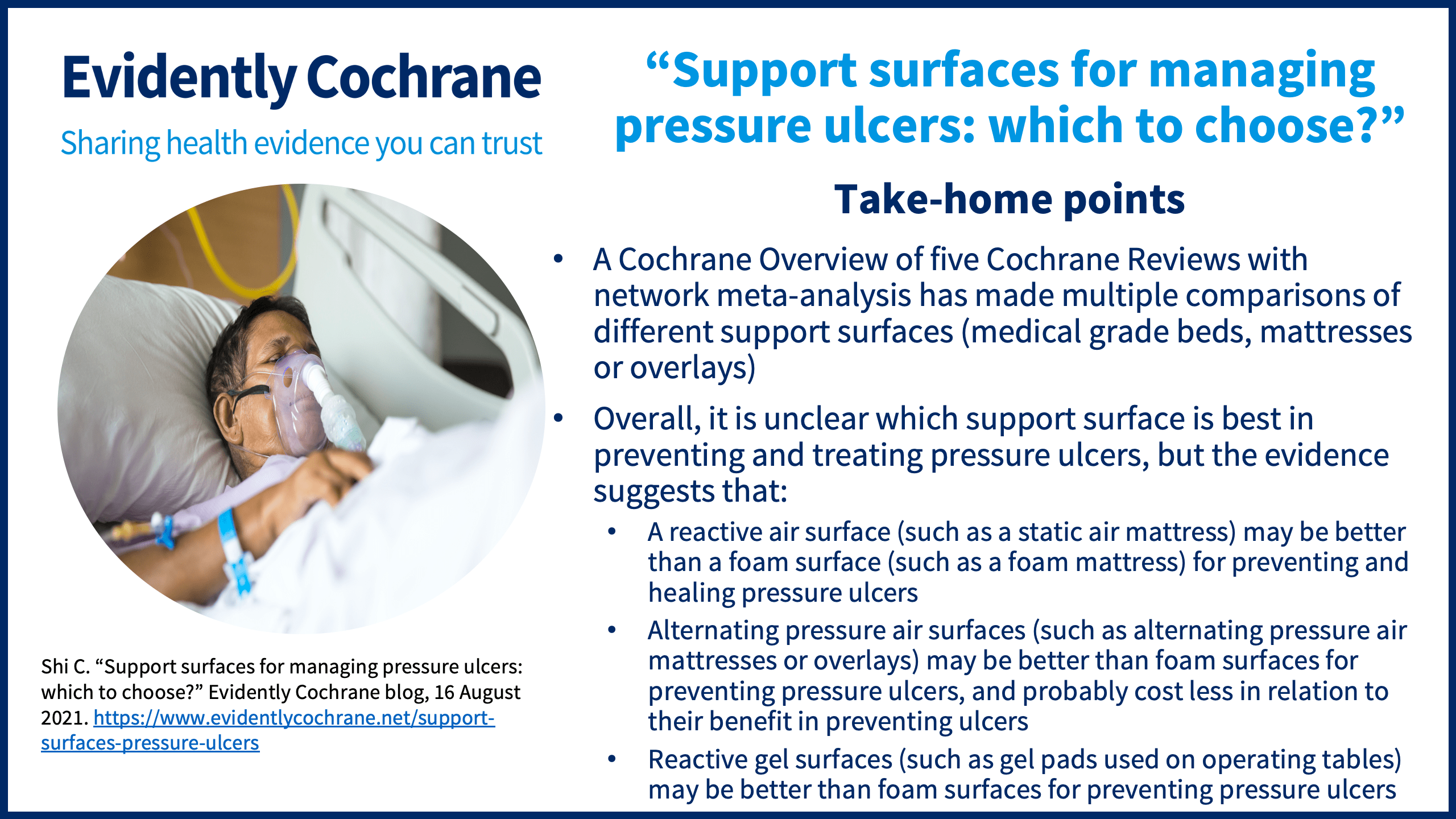On this page you can find Cochrane evidence on preventing and treating pressure ulcers (pressure injuries), including resources that aim to make it useful and accessible, as well as links to the reviews themselves.
You can either scroll through this page or click on the topics below to jump to a particular section.
Page last updated 22 December 2022
- Risk assessment tools
- Support surfaces
- Repositioning
- Dressings and topical agents
- Evidence-based practice?
- NICE Guidance on pressure ulcers
- Surgery
1
Risk assessment tools
Key message: “The low, or very low certainty of evidence available from the [two] included studies is not reliable enough to suggest that the use of structured and systematic pressure ulcer risk assessment tools reduces the incidence or severity of pressure ulcers.”


2
Support surfaces
In the blog Support surfaces for managing pressure ulcers: which to choose? Chunhu Shi, a nurse and lead author of a Cochrane Overview shares what the latest evidence tells us about support surfaces for managing pressure ulcers, and what we still don’t know.



- How do beds, overlays, and mattresses compare for prevention of pressure ulcers?
- How do beds, overlays, and mattresses compare for the treatment of pressure ulcers?

It concludes “There is no randomised evidence that supports or refutes the role of pressure redistributing static chairs in the prevention or management of pressure ulcers. This is a priority area and there is a need to explore this intervention with rigorous and robust research.” The NICE guideline takes this up, making a research recommendation: “Do pressure redistributing devices reduce the development of pressure ulcers for those who are at risk of developing a pressure ulcer? The currently empty Cochrane Review (February 2022) on pressure redistributing static chairs for preventing pressure ulcers, which you include in the blog, affirms the need for this research, especially considering the cost of these chairs: the UK NHS Supply Chain (2022) lists 307 chairs ranging in cost from £270 to £2500. Efficacy and cost-effectiveness still need to be established.”
3
Repositioning
Repositioning for prevention of pressure ulcers/pressure injuries
Key messages:
- “There remains a lack of robust evaluations of repositioning frequency and positioning for PI prevention and uncertainty about their effectiveness.
- It remains unclear whether repositioning every three hours using the 30° tilt versus “usual care” (90° tilt) or repositioning 3‐to‐4‐hourly versus 2‐hourly is less costly relative to nursing time.”


- How does frequency of repositioning affect pressure injury in older adults?
- How do different tilt positions affect pressure injury when older adults are repositioned?
Repositioning for treatment of pressure ulcers/pressure injuries
Key message: “Despite the widespread use of repositioning as a component of the management plan for individuals with existing pressure ulcers, no randomised trials exist that assess the effects of repositioning patients on the healing rates of pressure ulcers.”

4
Dressings and topical agents
Key message: “we are unable to determine which dressings or topical agents are the most likely to heal pressure ulcers”.
Maggie Westby, Jo Dumville and Gill Norman, three of the authors of the Cochrane Review ‘Dressings and topical agents for treating pressure ulcers’ (June 2017), explain more in their blog Dressings and topical agents for healing pressure ulcers: which should we choose?, including what network meta-analysis is and how they used it to compare treatments.


5
Evidence-based practice?
Evidently Cochrane blogs:
- Pressure ulcer prevention and treatment. Is ‘best practice’ evidence-based?
- Everyday practice: tried, trusted and tested?
6
NICE Guidance on pressure ulcers
National Clinical Guideline Centre, National Institute for Health and Care Excellence (commissioner). Pressure ulcer management: the prevention and management of pressure ulcers in primary and secondary care. London: National Institute for Health and Care Excellence; 2014 (NICE CG179). [Issued April 2014]. Available from: http://guidance.nice.org.uk/CG179
7
Surgery
Addressing a priority research question identified by the James Lind Alliance Priority Setting Partnership on Pressure ulcers, the Cochrane Review Reconstructive surgery for treating pressure ulcers (published October 2022) concludes “Currently there is very little randomised evidence on the role of reconstructive surgery in pressure ulcer management, although it is considered a priority area. More rigorous and robust research is needed to explore this intervention.”
Join in the conversation on Twitter with @CochraneUK @SarahChapman30 or leave a comment on the blog.
Please note, we cannot give specific medical advice and do not publish comments that link to individual pages requesting donations or to commercial sites, or appear to endorse commercial products. We welcome diverse views and encourage discussion but we ask that comments are respectful and reserve the right to not publish any we consider offensive. Cochrane UK does not fact check – or endorse – readers’ comments, including any treatments mentioned.
Sarah Chapman has nothing to disclose.


